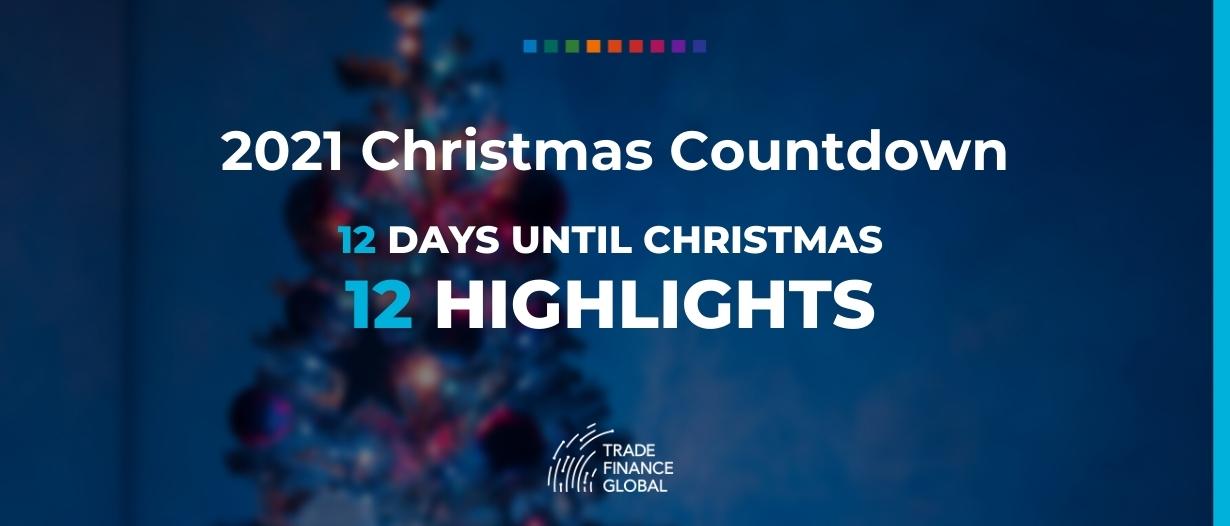It’s that time of year again: Yuletide cheer and all things merry are upon us.
This festive season our exciting Christmas countdown features several members of the Trade Finance Global (TFG) team in a game of trade trivia!
Join us as we unveil and explore an element of trade per day, until Christmas Day. Look out for our updates and feel free to play along!
Day 10: Asset Tokenisation
Asset tokenisation is the process by which an issuer creates digital tokens on a distributed ledger or blockchain, which represent either digital or physical assets.
Tokenisation can be applied to regulated financial instruments such as equities and bonds, tangible assets such as real estate, precious metals, and even tokenisation of copyright to works of authorship (e.g., music) intellectual property.
Benefits of asset tokenisation include a broader investor base, broader geographic reach, and increased settlement times.
However, one of the most attractive elements of asset tokenisation is its creation of an immutable, traceable audit trail. From loan origination to primary issuance–and changes in ownership in the secondary market–blockchain can create a chronological and immutable audit trail of all transactions.
This allows banks and businesses to track goods throughout the entire supply chain.
Did you know that ANZ Bank tracks its whisky distribution through its supply chain via asset tokenisation?
Day 9: Made in China
The top exports of China are broadcasting equipment ($223 billion), computers ($156 billion), integrated circuits ($120 billion), and office machine parts ($86.8 billion).
The top imports of China are crude petroleum ($150 billion), integrated circuits ($144 billion), iron ore ($99 billion), cars ($42 billion), and soybeans ($37.4 billion).
However, China’s exports and imports shrank at their steepest pace in at least two and a half years in November.
COVID-led production disruptions and a property slump at home piled pressure on the world’s second-biggest economy.
Exports contracted 8.7% in November from a year earlier, a sharper fall from a 0.3% loss in October and marked the worst performance since February 2020.
While Beijing is easing some of its more stringent restrictions, outbound shipments have been declining since August due to rising inflation.
Even with rising inflation, the world wants their Christmas decorations! Around $6 billion worth of Christmas decorations is exported from China annually.
Day 8: United Arab Emirates
The United Arab Emirates (UAE) borders Oman and Saudi Arabia by land, Iran and Qatar by sea.
The top exports of the UAE are crude petroleum ($42 billion), gold ($28.8 billion), and refined petroleum ($21.5 billion).
The pandemic dealt a twin blow to the UAE’s economy, driving down oil prices––reducing the country’s oil revenues––and significantly impacting the non-oil economy dependent on aviation, tourism, and trade.
As a result, real gross domestic product (GDP) fell by 6.1% in 2020 before picking up with a growth rate of 2.1% in 2021 and a projected growth rate of 3% in 2022, according to the International Monetary Fund (IMF).
The UAE didn’t let an economic slowdown stop their Christmas spirit! The Emirates Palace Hotel spent an estimated $11 million on their Christmas tree in 2022!
Day 7: Inflation
Hiking inflation rates in 2022 resulted in some of the highest Consumer Prices Indexes (CPI) the world had seen in decades.
Earlier in the year, the Bank of England announced that it “will not hesitate” to raise rates to control inflation, and it was forced to intervene in bond markets to prevent a collapse in prices and of pension funds struggling to meet margin calls.
This is but one example of how inflation has resulted in market uncertainty, depreciating currencies and reducing purchasing power.
Despite the overall volatility in the market, indicators are finally pointing towards a cooling down of hikes.
The US Bureau of Labor Statistics inflation report showed a drop in rates, signifying that the market may be steering toward an equilibrium.
Inflation has impacted all parts of life in 2022, including Christmas decorations! The average Christmas tree in the UK increased from £48 in 2021 to £54 in 2022!
Day 6: Shipping/Logistics
Shipping is the backbone of international trade and the global economy, with over 80% of the volume of international trade and goods being carried by sea.
Liner shipping, bulk shipping, and dry bulk shipping are the core three sectors of the industry, providing a means of transport for various different commodities.
Maritime transport has existed as an important element of trade for millennia, building an ecosystem that is heavily dependent on dated laws and processes.
Electronic Bills of Lading (eBLs) have been the ‘hot topic’ of discussion in this regard. The digitalisation of Bills of Lading (BLs) is thought to be able to save $6.5 billion in direct costs and enable $40 billion in global trade.
With legal adoption of eBLs on the uptick––where the UK seems to be the next in line––businesses are less and less able to ignore the winds of change.
Did you know that 80% of worldwide Christmas gifts are shipped from China?
Day 5: Payments
The payments space has been seeing a gradual evolution over the course of the last decade.
COVID-19 played a large part in expediting even further innovation.
More recently, the growing adoption of––and concerted industry migration to––ISO 20022 in the cross-border and high-value payments space promises to be valuable.
SWIFTgpi and ISO 20022 provide much-needed incremental improvements to the traditional cross-border payments space but aren’t moving the needle far enough.
The proliferation of real-time payments means that the traditional batch-based processes are no longer adequate to meet the immediate payments processing time mandates.
Liquidity must therefore be managed 24 hours a day to ensure the availability of funds for both customers and the bank’s real-time payments, alongside clearing and settlement systems.
The holiday rush isn’t over for banks and payment systems until after New Years, as Brits are estimated to spend £3.7 billion in post-Christmas purchases!
Day 4: Buy Now, Pay Later
Buy now, pay later (BNPL) is a type of short-term financing that allows consumers to make purchases and pay for them at a future date.
For businesses, this can mean a freeing up of cash flow, allowing for the financing of short-term growth.
It is important to remember that BNPL plans are a form of credit. And although offering these sorts of B2B credit terms opens up the market for many companies, so too does it invite a decent amount of risk.
Most pertinently, suppliers are usually at a disadvantage with trade credit as they have sold goods but have yet to receive payment.
However, there is room for innovation in the B2B BNPL space, with major opportunities sprouting in sectors from healthcare to home improvement.
BNPL plans are growing rapidly every year, 20% of UK shoppers used a BNPL scheme in 2021!
Day 3: E-commerce
Many companies saw exponential tech growth as a result of the COVID-19 pandemic.
As a result, the manufacturing process within commodities exchange saw an uptick in revolutionary production processes in particular. There was a sweeping rise of software platforms, most notably, e-commerce technology.
In order to meet the growing consumer demand resulting from these accessibility advancements, businesses in the market have had to make sure their finance solutions are able to keep pace.
Managing customer demand is but one facet, as there is much room for businesses to reap significant economic rewards through developing financing platforms, especially in emerging markets.
Allowing for a more digitalised economy in these areas will drive innovation and high-level growth for underfunded or traditionally overlooked small businesses.
The digital economy is making it easier for Christmas shoppers in 2022, as 87% of people plan on ordering their presents online this year!
Day 2: Commodities and oil
Gas and oil was a sector that saw considerable volatility in 2022.
The Russia-Ukraine conflict initiated a series of events that led to significant fuel import reductions for many EU member states and beyond.
Russian oil exports fell by 230 kb/d to 7.5 mb/d in September, down 560 kb/d from pre-conflict levels.
The effects of these significant slashes have been compounded by OPEC+ bloc’s supply cuts, thereby slowing world oil demand.
This has resulted in a derailing of the growth trajectory for oil supply through the remainder of 2022 and 2023, with the resulting higher price levels exacerbating market volatility and heightening energy security concerns.
In end-August, OECD industry inventories remained at a steep 243 million barrels (MB) below the five-year average, at 2 736 MB.
Large spikes in oil prices have spurred a strong investment response leading to greater supply from non-OPEC producers, but will that be enough to even the market?
Santa’s annual voyage requires roughly 45 million gallons of fuel. Christmas will be expensive for Santa this year!
Day 1: Emerging markets
2022 was a year of extreme volatility for the trade finance market, but it was one that shone more of a direct light on emerging markets.
Specifically, Africa has led the discourse on how the industry can help improve access to trade finance in emerging markets.
Nigeria, an African country on the Gulf of Guinea, is one of Africa’s most populous countries, with 211 million residents.
The country has a mixed economy focused on petroleum––of which crude oil accounted for 79.7% of total exports at the end of Q2 2022––and (to a lesser extent) agriculture. It is also an emerging market with growing financial, service, communications, and technology sectors.
Despite the area for growth, Nigeria has recorded a negative trade balance quarter-on-quarter in 2022.
The third quarter of 2022, Nigeria’s total trade stood at ₦11.59 trillion, this was lower than the value recorded in Q2 2022 (₦12.84 trillion) but was higher than the value recorded in the corresponding period of 2021.





























